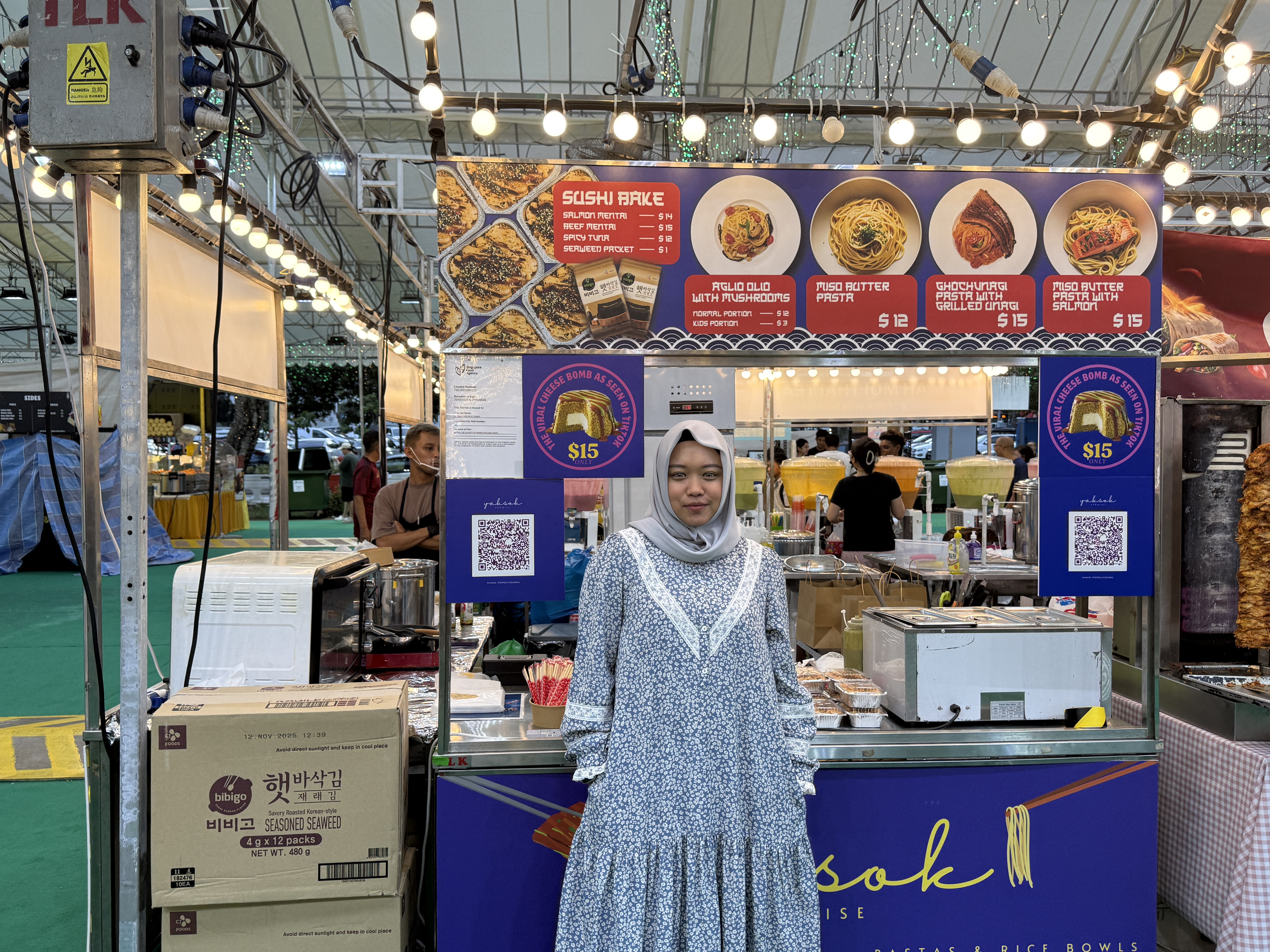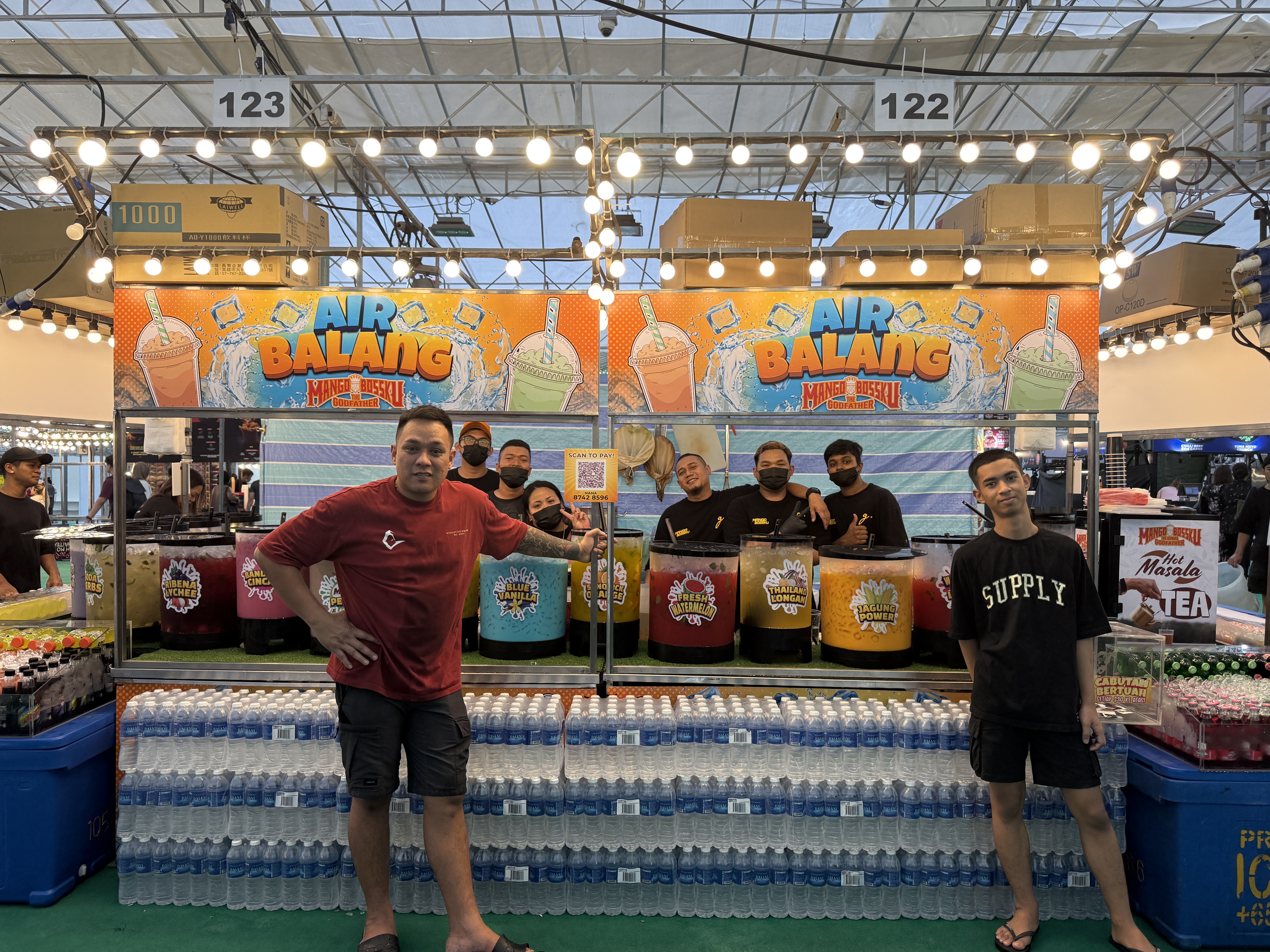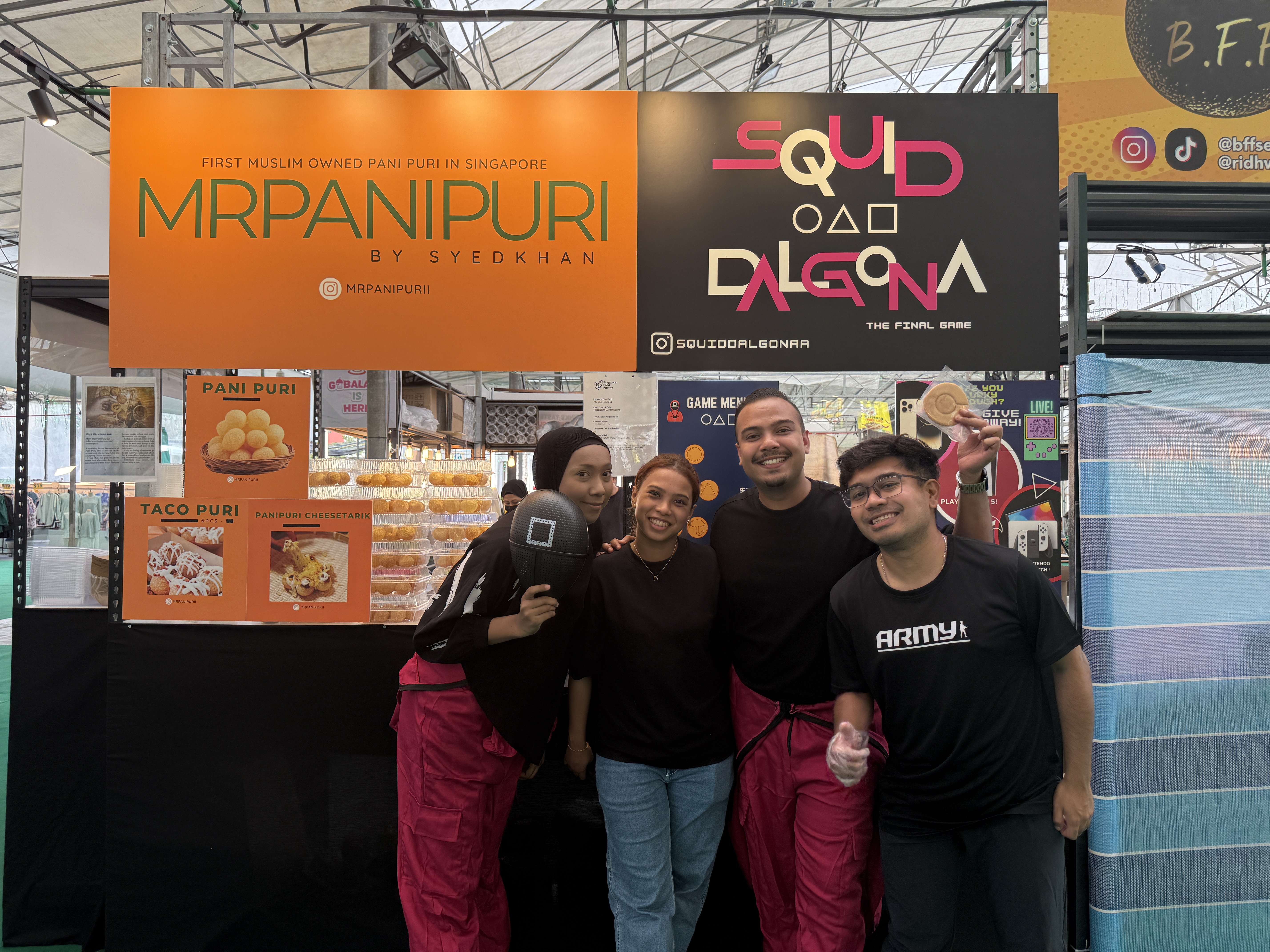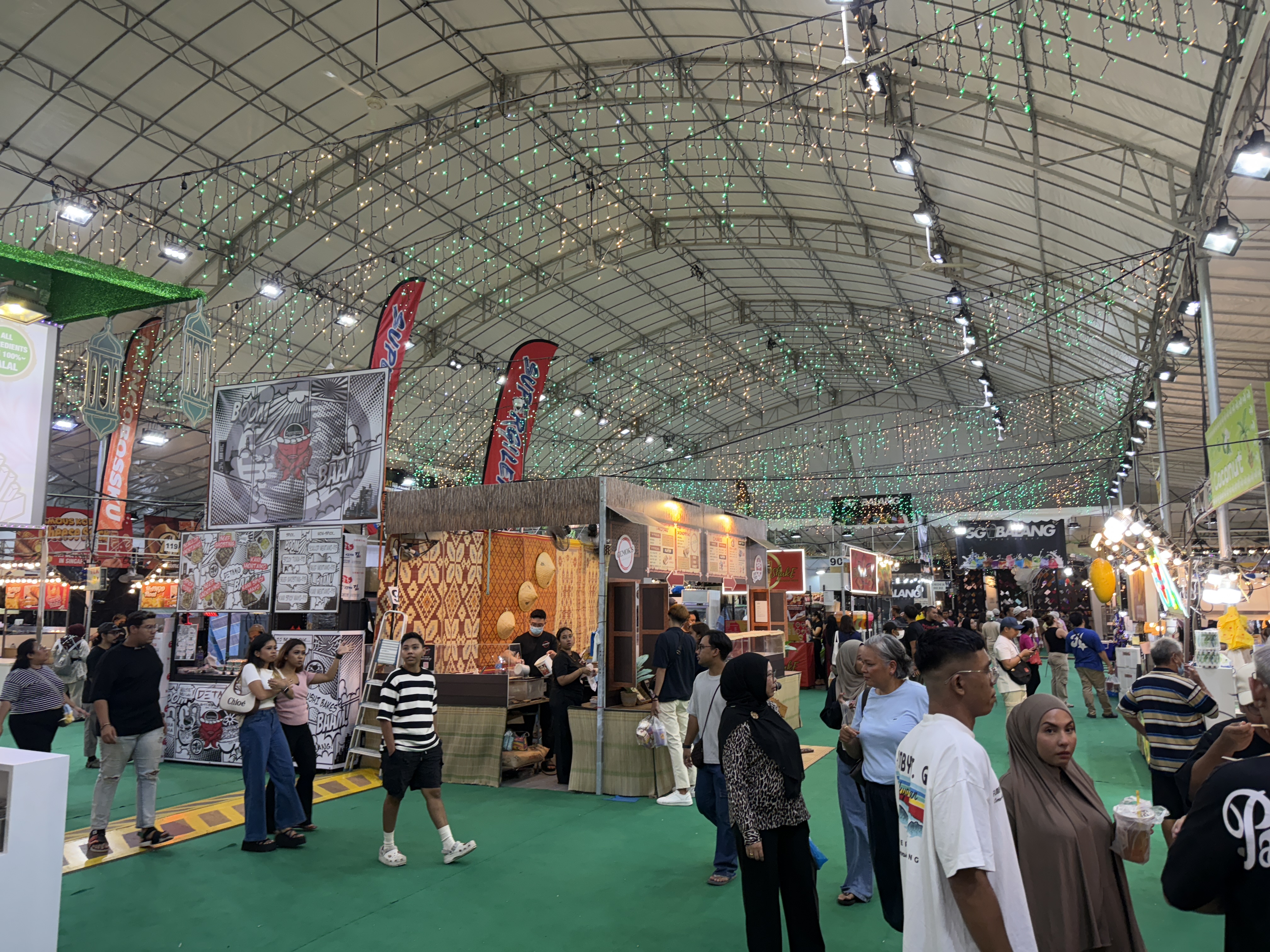You are using an out of date browser. It may not display this or other websites correctly.
You should upgrade or use an alternative browser.
You should upgrade or use an alternative browser.
[Sg video] Chiobu owner of Corndog stall at Pasar Malam losing $10k of her hard earned money due to low customer footfall, asks public to help support
- Thread starter UltimaOnline
- Start date
- Joined
- Apr 28, 2025
- Messages
- 40
- Points
- 8
who did she vote for?
- Joined
- Oct 15, 2023
- Messages
- 14,088
- Points
- 113
The organiser is a scammer who charges $500 per night when there is hardly any footfall even on weekends. The weather has been so hot and humid with rain in between. How to attract potential customers? Everybody is hiding in aircon comfort inside malls or at home.
- Joined
- May 16, 2023
- Messages
- 40,152
- Points
- 113
Jiuhu bu? Wify material?who did she vote for?
- Joined
- Apr 14, 2011
- Messages
- 18,745
- Points
- 113
Wifu and whore material. Bestest!Jiuhu bu? Wify material?
- Joined
- May 16, 2023
- Messages
- 40,152
- Points
- 113
GL150 good service attitude and commando skill?Wifu and whore material. Bestest!
- Joined
- Aug 10, 2008
- Messages
- 108,129
- Points
- 113
It is my opinion that pasar malam stalls should be rent-free, or only charged rent based on the percentage of total collected sales revenue.
And remove those stupid restrictions e.g. adult toys, aquarium creatures. Go to JB to see how a proper pasar malam is managed.
And remove those stupid restrictions e.g. adult toys, aquarium creatures. Go to JB to see how a proper pasar malam is managed.
- Joined
- Aug 7, 2008
- Messages
- 5,542
- Points
- 113
Have more variety in the menu. I doubt you can pull in $500 everyday just by selling corn dogs alone.
there also posted a separate beedio thanking all the kum gong simps who rushed down to sarpork her
- Joined
- Jun 27, 2018
- Messages
- 30,963
- Points
- 113
But Ramadan Bazarr also not cheap...but guess its a captive market.Pasar malam should be in housing estates. And the most only $50/ day. As most people walk to pasar malam. They don't drive kilometres, away just to get there. That way you create a bottom up economy to survive and thrive.
Our problem is highly paid authorities are living in another world. They have no idea how to ignite the entrepreneurial spirit.
‘Thankful to break even’: Vendors share what it takes to run a stall at Geylang Serai bazaar
Not an easy feat.
March 26, 2025, 03:07 PM

Do you know of an F&B place that should be featured on Mothership? Tell us more at [email protected].
As Ramadan comes to a close, so are the numerous bazaars that have popped up all over the island.
One of the more iconic Ramadan bazaars, of course, is the Bazaar Raya Geylang Serai.
This year, the bazaar runs for a total of 33 days till Mar. 31.View this post on Instagram
In 2024, a maximum rental cap of S$15,000 was imposed for last year's bazaar. For several vendors this year, however, that amount is just the tip of the iceberg.
Despite the daunting numbers, it has not stopped vendors — both new and seasoned — from participating in the annual affair.
Vendors spent at least S$15,000
Speaking to Mothership, several stall owners shared that S$15,000 does not include fixtures and other overheads.To make it more comfortable for her staff in the blazing heat, vendor Raudhah Osman spent more on fixtures including a fan, bringing the total cost to S$19,000.

The co-owner of Korean-Japanese fusion hawker stall Yaksok said: "The greater challenge would be the heat because it's a confined space [and] with the human traffic, it's going to be pretty hot. Especially when we're fasting. So we got the contractor to install a fan because my staff need it."
While Yaksok is no stranger to pop-ups like the Kampong Gelam bazaar and events like Celebfest, this is the eatery's first time at the Geylang bazaar.
And for the first time, Yaksok will be having two completely different menus at the Kampong Gelam and Geylang bazaars.
"For the Kampong Gelam bazaar, we are focusing on our signature sushi bakes. Over here [at Geylang], we have pastas, sushi bakes as well as the viral pistachio cheese bomb."
View this post on Instagram
Bracing for different experience
When asked if there are differences between pop-ups and Ramadan bazaars, Raudhah said: "What you can achieve [at a] three-day pop-up, you'd probably need about a week at a bazaar."She explained that since pop-ups run over shorter periods, crowds are expected.
Meanwhile, as the bazaar is a month-long affair, the crowd "comes and goes".
Despite the differences, Raudhah remains hopeful.
"We are bracing ourselves enough for a different experience, even though we have been in other bazaars."
One man, 12 stalls
Mohammad Hussin (also known as Mangobossku), on the other hand, is a familiar face at the yearly bazaar.
A regular vendor since 2022, Hussin is known for popularising "crispy kunafa" in Singapore.
This year, the 39-year-old hired over 30 staff and took up a total of 12 lots at the bazaar: eight F&B lots and four retail lots.
The straight-talking man told us that aiming for S$1 million is "enough already" for this year.
While some may be sceptical of his financial goals, Hussin shared that he has hit more than that amount in the past years.
How to do well in bazaars?
With over 54,000 followers on TikTok, he uses social media regularly to market his stalls and other vendors at the bazaar.Thanks to his social media presence, long queues are seen almost daily at his kunafa and air balang stalls.
On top of that, he is also running a lucky draw with 50 prizes, including several iPhone 16 sets, cash prizes, and even a car.
Another strategy to run a stall in Geylang bazaar, according to Hussin, is to bring in new types of food and drinks.
He said: "I think no one else in Singapore has brought it in yet — Turkish wet burgers. So this year, I brought this item in."
Beyond selling viral food, Hussin shared that pricing is also an important factor when it comes to surviving in bazaars.
"We have to sell items that are [not too] expensive and sell as cheap as we can, and sell in [large] volumes."
Bringing in new experiences
Another regular at pop-up events and the Geylang bazaar is 27-year-old Syed Shamroz Khan.
Like past years, the Mr Pani Puri founder is selling pani puri, a popular Indian street food.
Syed also brought in his latest concept, Squid Dalgona.
Dressed like the guards from Netflix series "Squid Game", Syed drew inspiration from the series to bring the trendy sugary snack to the bazaar.
While he'd be "thankful" to be able to break even at the bazaar, Syed stressed that his primary goal is to bring new experiences to his customers.
To give back to his customers, Syed is also running a lucky draw for his customers with prizes like a Nintendo Switch and a PlayStation 5."My main purpose of coming to the bazaar is always to bring something interesting and new for my customers. So at least [our customers] get to enjoy things that we bring in from around the world...
Like how I brought India here [with pani puri] and now I bring Korea here [with dalgona candy]."
View this post on Instagram
"This lucky draw is also a way for me to give back for all the support they have given Mr Pani Puri."
The "heartland" of Ramadan bazaars

Goals and aspirations aside, all three vendors agree that Geylang bazaar is synonymous with Ramadan and Hari Raya season.
"This is the heartland of Ramadan bazaars," said Hussin.
Resonating with Hussin's opinions, Syed added that the Geylang bazaar holds special memories for him and his family."I'd say about 90 per cent [of the community] will still come to Geylang bazaar. The vibes over here is just different."
Smiling warmly, he said: "Why do I keep coming back? My parents are also in the industry, and they also started in Geylang many years back."
Congratulations! You have made it to the end of the article (whether by speed-scrolling or otherwise). This alone qualifies you to apply for the role of an Editorial Intern (Nova) at Mothership. Click here to find out more.
Top image by Livia Soh.
ADVERTISEMENT
Follow us on Facebook, Instagram, Twitter and Telegram to get the latest updates.ADVERTISEMENT
MORE STORIES
Nova
- Joined
- Jun 27, 2018
- Messages
- 30,963
- Points
- 113
You want to eat her or her Corndog?
https://www.tnp.sg/news/we-need-you...-night-bazaar-risks-10k-loss-due-low-footfall
Will she be added to the statistics?
- Joined
- Sep 2, 2023
- Messages
- 4,095
- Points
- 113
 I can go there help to burn down the whole place as the food is shit anyway
I can go there help to burn down the whole place as the food is shit anyway- Joined
- Jun 27, 2018
- Messages
- 30,963
- Points
- 113
Viral TikTok boosts sales at Bayfront bazaar, but vendors like Kwazy Korndog still foresee S$10K losses
A TikTok plea by Kwazy Korndog co-owner Hazel Chen drew thousands to the Bayfront food bazaar, but the couple behind the stall says the crowd surge is not enough to recover expected losses exceeding S$10,000.
Published
on
2 August 2025
Kwazy Korndog co-owner Hazel Chen at her stall at the Bayfront food bazaar, with the sign showing just 28 customers.
A viral TikTok video posted by Hazel Chen, co-owner of Kwazy Korndog, has brought renewed attention and customer footfall to the Singapore National Day Food Festival at Bayfront Event Space.
But despite the social media-driven support, Hazel and her husband Kay Lam say they remain on track to incur losses of over S$10,000.
The 16-day event, which runs from 26 July to 10 August, was intended as a flagship National Day celebration, featuring a large-scale night market, carnival rides and local street food. However, early turnout was alarmingly low, prompting Hazel to post a heartfelt appeal online.
In her now-viral TikTok video, Hazel began by stating plainly, “We are on the verge of losing 10K.”
She added, “We need your help.” Despite the venue’s visual appeal, she said, “The location is good, the setup is pretty, but the crowd is just not coming in.”
“We just feel very hopeless,” she added, “and we have to take it upon ourselves to bring in as many people as possible.”
The video quickly went viral, racking up over 540,000 views on TikTok.
“It’s very heartwarming to see Singaporeans being so supportive of our small businesses,” Hazel told The Online Citizen in an on-site interview. “After that viral video, there really was an increase in footfall here. Everyone’s really buying from everybody also.”
Despite the surge, she was clear-eyed about the limitations. “We started the stall on 26 July and pay S$8,000 for the entire 16 days, which is about S$500 per day,” Hazel said. “Even with the increase in customers, we are still unlikely to break even.”
Kwazy Korndog’s daily operating costs include not just rent but also manpower, electricity, and ingredients. Kay Lam estimated the total loss could exceed S$10,000. “The original forecast was somewhere around S$10K to S$12K,” he said. “After the video, maybe we can cushion that loss a bit, especially with National Day coming. But break even? Very hard.”
The couple has a history of running pasar malam stalls and previously operated at Geylang and Hougang. Hazel observed a key difference with the Bayfront venue. “Pasar malam is usually in heartland areas with built-in crowd. This one is different—you must tell people to come, otherwise they won’t,” she said.
She added that despite the picturesque setup and central location beside Marina Bay Sands, the site lacks the organic foot traffic seen in residential neighbourhoods. “It’s not a place people pass by daily,” Hazel noted.
Before the video gained traction, sales were dismal. Daily takings had fallen as low as S$14, far below the S$500 daily rent. This led the couple to take matters into their own hands with social media outreach.
Hazel stressed the importance of aggressive advertising. “This place really needs marketing. You can’t just rely on the location,” she said. While grateful for the event organiser’s efforts, she felt they had not gone far enough.
The organiser, Singapore Night Bazaar, previously said it had spent over S$20,000 on marketing, including social media promotions and street-level engagement. However, Hazel said the results suggest that more is needed. “This is not the kind of place where people stumble upon you,” she said. “You have to pull them in.”
Kay added that while the video brought short-term relief, it may not be sustainable. “The weekdays are still quiet. We’re hoping the final weekend and National Day will bring more traffic, but we can’t count on it.”
The couple expressed deep appreciation for those who came to support, both in person and online. “Even if you just comment and share, you help boost the algorithm,” Hazel said. “That helps not just us, but all the vendors here.”
Kwazy Korndog’s menu includes SG60-themed items like the Milo Corn Dog and Mantou Corn Dog, priced from S$7 to S$9. Though they have seen greater success at previous events, Hazel and Kay are now focusing on minimising losses and supporting neighbouring vendors.
“This worked out for all of us in some way, even if it doesn’t fix everything,” Hazel said. “We’re very, very thankful.”
A TikTok plea by Kwazy Korndog co-owner Hazel Chen drew thousands to the Bayfront food bazaar, but the couple behind the stall says the crowd surge is not enough to recover expected losses exceeding S$10,000.
Published
on
2 August 2025
Kwazy Korndog co-owner Hazel Chen at her stall at the Bayfront food bazaar, with the sign showing just 28 customers.
A viral TikTok video posted by Hazel Chen, co-owner of Kwazy Korndog, has brought renewed attention and customer footfall to the Singapore National Day Food Festival at Bayfront Event Space.
But despite the social media-driven support, Hazel and her husband Kay Lam say they remain on track to incur losses of over S$10,000.
The 16-day event, which runs from 26 July to 10 August, was intended as a flagship National Day celebration, featuring a large-scale night market, carnival rides and local street food. However, early turnout was alarmingly low, prompting Hazel to post a heartfelt appeal online.
In her now-viral TikTok video, Hazel began by stating plainly, “We are on the verge of losing 10K.”
She added, “We need your help.” Despite the venue’s visual appeal, she said, “The location is good, the setup is pretty, but the crowd is just not coming in.”
“We just feel very hopeless,” she added, “and we have to take it upon ourselves to bring in as many people as possible.”
The video quickly went viral, racking up over 540,000 views on TikTok.
“It’s very heartwarming to see Singaporeans being so supportive of our small businesses,” Hazel told The Online Citizen in an on-site interview. “After that viral video, there really was an increase in footfall here. Everyone’s really buying from everybody also.”
Despite the surge, she was clear-eyed about the limitations. “We started the stall on 26 July and pay S$8,000 for the entire 16 days, which is about S$500 per day,” Hazel said. “Even with the increase in customers, we are still unlikely to break even.”
Kwazy Korndog’s daily operating costs include not just rent but also manpower, electricity, and ingredients. Kay Lam estimated the total loss could exceed S$10,000. “The original forecast was somewhere around S$10K to S$12K,” he said. “After the video, maybe we can cushion that loss a bit, especially with National Day coming. But break even? Very hard.”
The couple has a history of running pasar malam stalls and previously operated at Geylang and Hougang. Hazel observed a key difference with the Bayfront venue. “Pasar malam is usually in heartland areas with built-in crowd. This one is different—you must tell people to come, otherwise they won’t,” she said.
She added that despite the picturesque setup and central location beside Marina Bay Sands, the site lacks the organic foot traffic seen in residential neighbourhoods. “It’s not a place people pass by daily,” Hazel noted.
Before the video gained traction, sales were dismal. Daily takings had fallen as low as S$14, far below the S$500 daily rent. This led the couple to take matters into their own hands with social media outreach.
Hazel stressed the importance of aggressive advertising. “This place really needs marketing. You can’t just rely on the location,” she said. While grateful for the event organiser’s efforts, she felt they had not gone far enough.
The organiser, Singapore Night Bazaar, previously said it had spent over S$20,000 on marketing, including social media promotions and street-level engagement. However, Hazel said the results suggest that more is needed. “This is not the kind of place where people stumble upon you,” she said. “You have to pull them in.”
Kay added that while the video brought short-term relief, it may not be sustainable. “The weekdays are still quiet. We’re hoping the final weekend and National Day will bring more traffic, but we can’t count on it.”
The couple expressed deep appreciation for those who came to support, both in person and online. “Even if you just comment and share, you help boost the algorithm,” Hazel said. “That helps not just us, but all the vendors here.”
Kwazy Korndog’s menu includes SG60-themed items like the Milo Corn Dog and Mantou Corn Dog, priced from S$7 to S$9. Though they have seen greater success at previous events, Hazel and Kay are now focusing on minimising losses and supporting neighbouring vendors.
“This worked out for all of us in some way, even if it doesn’t fix everything,” Hazel said. “We’re very, very thankful.”
- Joined
- Sep 14, 2014
- Messages
- 6,855
- Points
- 113
Kum lan
- Joined
- Oct 15, 2023
- Messages
- 14,088
- Points
- 113
Rental is killing entrepreneurship in S'pore. Soon, most Sinkies will cook at home; most of us already shop, order takeout food, do banking etc. online. Since the govt doesn't want 90% of us to own a car, most residents would only travel short distances or stay home to do the needful.
Similar threads
- Replies
- 8
- Views
- 965
- Replies
- 0
- Views
- 683
- Replies
- 3
- Views
- 1K
- Replies
- 33
- Views
- 7K




